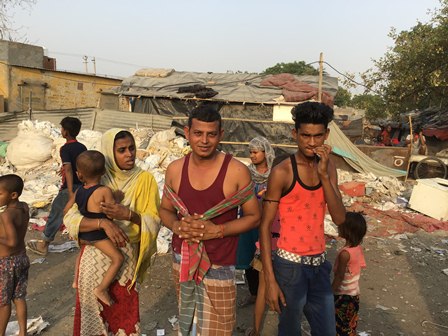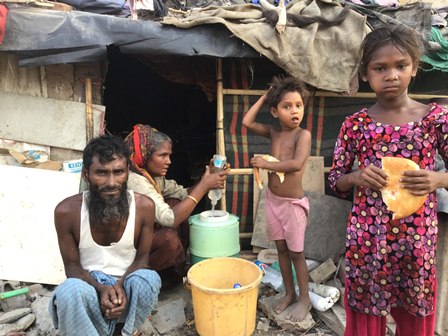Urban refugees in Delhi: An unheard story
“In the 21st century, Delhi finds itself at the heart of the refugee movement in the entire South Asia. While the city planners grapple with the problems of economic progress and focus their efforts to bring the citizens out of poverty, urban refugee population has been completely forgotten.”

India has been friendly nation when it comes to accepting people from various parts of the world. According to UNHCR, a ‘refugee’ is a person who is forced to flee their home-country due to violence and persecution.
The UNHCR’s data shows: two-thirds of all refugees worldwide come from just five countries – Syria, Afghanistan, South Sudan, Myanmar and Somalia. Forty million people are internally displaced (IDP) around the world. Ten million people around the world are stateless or at the risk of being stateless.
India has seen a greater inflow of refugee population than any other country in Asia throughout its history whether the refugees of The Partition of 1947, Tibetan refugees, Bangladeshi refugees, Pakistani refugees, Afghani refugees, Sri Lankan Tamilian refugees or the Rohingyas.
In 2019, India will be hosting around 41,000 mandated refugees and asylum seekers registered with UNHRC. Surprisingly, India hasn’t signed the 1951 Refugee Convention, which is a United Nations multilateral treaty that defines refugees and their rights. The Convention also sets out who do not qualify as refugees like the war criminals. But in the past, Government of India has recognised immigrants largely from Tibet and Sri Lanka and has provided them identification documents and free education.
“In 2019, the Government of India also reduced various requirements for non-Muslim illegal immigrants from Bangladesh, Afghanistan and Pakistan like reduction in their residency requirements from 12 years to just six years.”
Delhi, which is the heart of our nation, is also considered to be the heart of the refugees’ problem. Under UNHCR’s mandate, more than 60 per cent population of the world’s refugee population and 80 per cent IDP reside in urban environments.
Today, urban refugees in Delhi face countless problems and the concerned authorities appear to be unconcerned! Refugees face problems which affect their basic human rights as they struggle to live a life with dignity, with no citizenship, face discrimination and are seen as a constant threat to national security, they are forced to fight poverty with no sustainable means for their livelihood.
These refugees often fall in a vicious grey area between a migrant foreigner and a de-facto refugee. An increase in the anti-Muslim Hindu nationalist sentiment in the last few years has become a serious life threat for the Muslim refugees in Delhi.
Also Read : Guests of Destiny: Refugees in India
Delhi is a home to various heterogeneous refugees who encounter the same difficulty in achieving citizenship through the process of naturalisation. Many Muslim refugees and specially, Rohingya refugees, face discrimination and are amongst the city’s poorest. The main refugee settlement areas are Majnu ka Tila, Khazoori Khas, Vikaspuri, Janakpuri, Jangpura, Bhogal, Ashram, Lajpat Nagar, Malviya nagar, Sheikh Sarai, Kalindi Kunj and Shaheen Bagh. We can witness most of the refugee settlement areas are located near the heavily polluted river Yamuna.
According to UNHCR (2017), India provided shelter, support and asylum to around 20,000 refugees and a significant number comes from people living in Delhi. However, their legal and political situation is worsening year by year. With no proper regulatory framework on the statistics of the number of refugees living in Delhi, there’s a lot of difficulty in finding their accurate number.
Since, there is no statute or act which primarily focuses on the status of Urban Refugees, they are generally categorised as a ‘foreigner’ and fall under various acts like The Foreigner Act of 1946 and The Citizenship Act of 1955. These multiple Acts put refugees at the risk of being classified as illegal immigrants and face the threat of deportation.
“In terms of their protection, the country is obliged to follow international law. In reality, the legal framework is only provided to the UNHCR mandated refugees and two other refugee groups that entered India: Tibetans and Sri Lankan Tamils.”
There are several bills which were introduced in the Parliament aiming at providing protection to the refugees, but none have been passed yet. These include, Asylum Bill 2015, the National Asylum Bill 2015 and Protection of Refugees and Asylum Seekers Bill 2015.
But not all the pending bills have been positive for securing refugee protection in India. There is a much debated, controversial and government-sponsored bill – The Citizenship Amendment Bill, 2016 (CAB, 2016) which aims to amend the Citizenship Act,1955.

The bill if passed will be major threat to the Muslim refugees and will count a few ‘non-Muslim’ refugees as the potential citizens of India. Thus, this Bill has the potential to codify refugee protection in India on communal grounds.
Even though there are no refugee laws in India, we tend to follow UNHCR rules that empower various NGO partners across India.
The refugees prefer Delhi as a resettlement area since it’s easier to get the refugee card as mandated by UNHCR here than any other place in India. The ‘refugee card’ is the most useful document for the refugees against the atrocities of local authorities towards them. But, recently the introduction of Aadhaar Card has made the lives of the refugees miserable, as it has become a new identification card for everyone in India in accessing public services.
Many of the refugees lack language skills and are unskilled too. Also, Muslim refugees such as Afghani or Muslim Rohingya people don’t get jobs easily because of their ethnicity despite having magnificent language proficiency. Many of the refugees take up special training with the hope of getting a job. They generally get unskilled and low paid jobs.
According to IIED working paper 2017, 1324 refugees were registered in 2015 and 875 in 2016 (up to 31st March) for the jobs but only 50 refugees were in jobs that paid an average monthly salary of Rs 10,000 or more.
Also Read : No law to deal with refugees in India disturbs me: Ubais Sainulabdeen
For many refugees, shelter and food are the main priority and very less emphasis is given on education. Though free education is a fundamental right in India, rules are different for the urban refugees living in Delhi.
The government doesn’t help the refugees much, but they get assistance from the people living in their neighbourhood. These urban city spaces have become a source of livelihood for them.
“Many welfare societies in Delhi work for the upliftment of refugees. For instance, The Khalsa Diwan Welfare Society work to help Sikh and Hindu Afghan refugees. M.A.P (Migration and Asylum Project) is India’s first and only refugee law centre. It aims to adopt innovative methods to expand the protection space available for forced migrants and refugees.”
Every refugee in Delhi has his or her own share of antidotes. While most Afghans talk of feeling at home in Delhi, the Somalis feel marginalised and are generally mistaken as Nigerians in Delhi.
The refugees in Delhi are swinging between hope and despair. Large parts of today’s Delhi grew out of the refugee camps built after 1947. Delhi was constructed on the bags of diversity of various kinds of immigrants that kept coming here, you could turn your back and say, “none of them was a native Delhiite”. India is at the centre of several nations undergoing massive change, but its struggling to cope with its growing refugee population. India must continue to take good care of its urban refugees who are still struggling to get citizenship.
